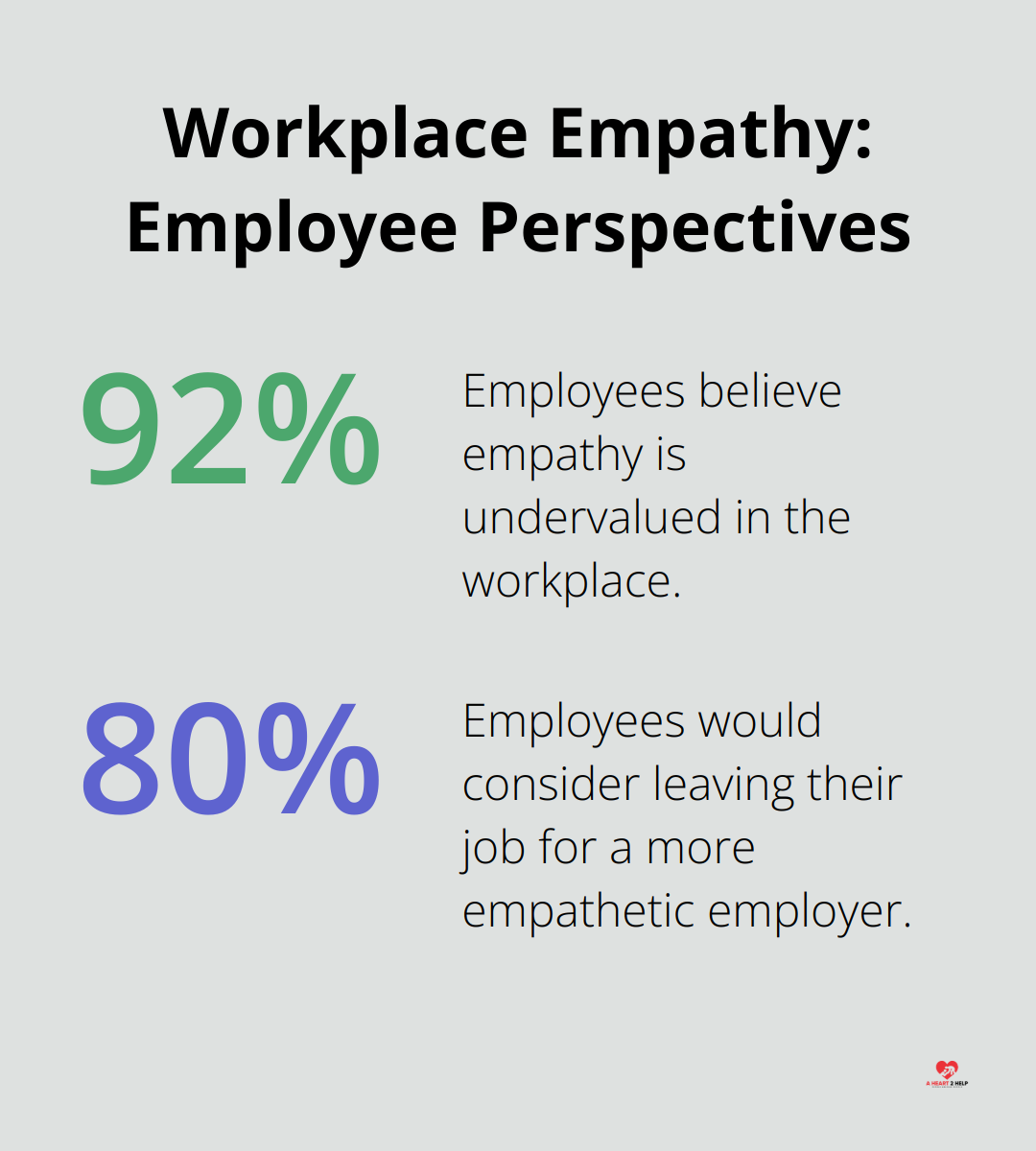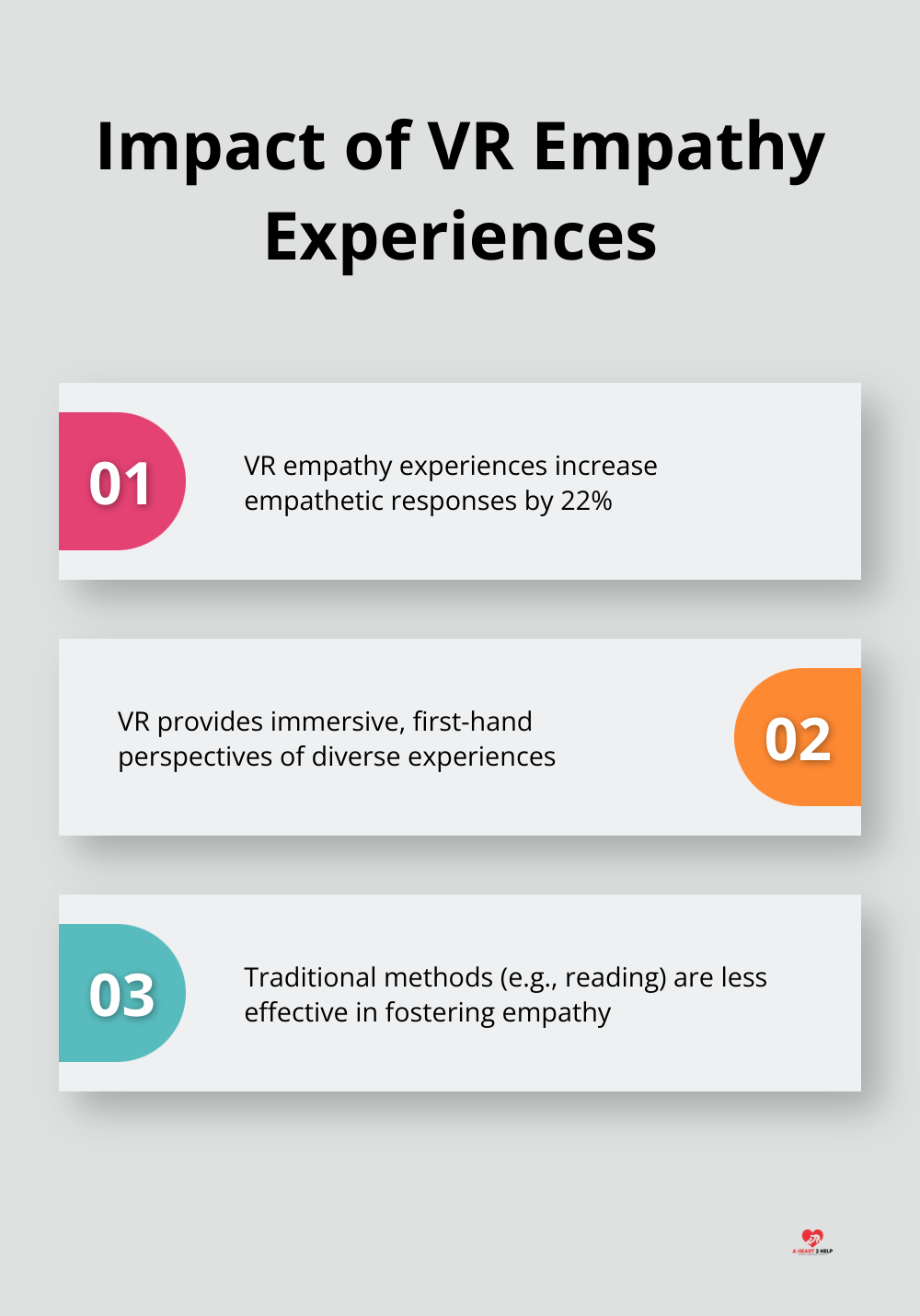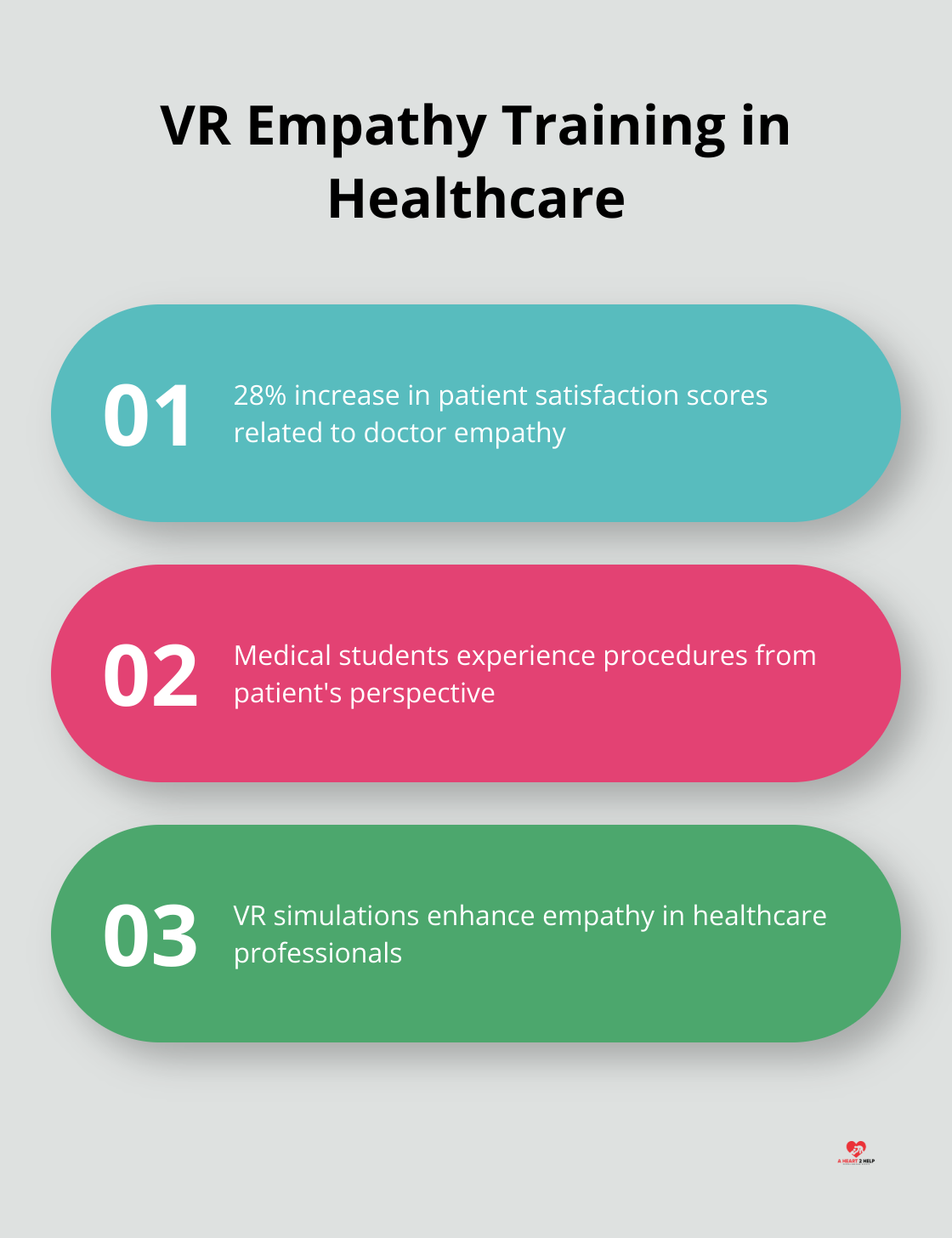Empathy tools are revolutionizing how we connect with others in our increasingly digital world. These innovative technologies help us understand and share the feelings of those around us, bridging gaps in communication and fostering deeper relationships.
At A Heart 2 Help, we’ve seen firsthand how these tools can transform personal and professional interactions. In this post, we’ll explore the top empathy tools of 2025 and how they’re shaping a more compassionate future.
Empathy in the Digital Age: Bridging Human Connections
Defining Empathy in 2025
Empathy stands as a cornerstone skill in our digital world. It represents the ability to understand and share another person’s feelings. Empathy involves stepping into someone else’s shoes and viewing the world through their lens.
The Digital Paradox
Despite our hyper-connected world, isolation prevails. A 2024 Pew Research Center study revealed that 68% of adults feel less connected to others compared to a decade ago, even with increased digital interactions. This paradox underscores the need for tools that foster genuine empathy in our digital communications.
Technology as an Empathy Catalyst
Contrary to popular belief, technology doesn’t inherently hinder empathy. When used intentionally, it can significantly enhance our ability to understand and connect with others. The widespread adoption of video calling during the COVID-19 pandemic (a prime example) allowed people to maintain visual cues and emotional connections, even when physically apart.
Empathy Tools in Action
Empathy tools bridge the gap between digital interaction and human connection. These tools range from AI-powered emotion recognition software to virtual reality experiences that literally put you in someone else’s shoes.
The EmotiSense app stands out as a notable example. It uses facial recognition and natural language processing to provide real-time feedback on the emotional state of the person you’re communicating with. This tool has proven particularly effective in remote work settings, where subtle emotional cues often go unnoticed.
Transforming Personal and Professional Relationships
In the workplace, empathy tools have shown remarkable results. According to a recent study, 92% of employees believe empathy is undervalued in the workplace, yet 80% would consider leaving their job for a more empathetic employer.

On a personal level, these tools help people maintain deeper connections with loved ones, even across great distances. The “Empathy Mirror” feature on popular social media platforms now allows users to experience a simulation of their friends’ daily lives, fostering a deeper understanding of their challenges and joys.
As we navigate the digital age, these empathy tools play an increasingly important role in maintaining and strengthening our human connections. They serve as a constant reminder that behind every screen, a real person with real emotions deserves our understanding and compassion. In the next section, we’ll explore some of the most popular empathy tools and their unique features that are shaping our interconnected world.
Overcoming Barriers to Empathy
While technology offers innovative solutions, it’s important to recognize that the digital age, stress, and political polarization hinder empathy. However, we can overcome these barriers through face-to-face interactions and mindfulness practices, complementing the digital tools at our disposal.
Empathy Tools That Transform Connections in 2025
Virtual Reality: A New Perspective
Virtual Reality (VR) empathy experiences have become powerful tools for cultivating understanding and compassion. The Empathy Engine, developed by Oculus, immerses users in the daily lives of people from diverse backgrounds. Users experience the challenges faced by refugees, individuals with disabilities, or those living in poverty. A Stanford University study found that participants who engaged in VR empathy experiences showed a 22% increase in empathetic responses compared to those who only read about others’ experiences.

AI-Powered Emotion Recognition: Decoding Human Feelings
AI-driven emotion recognition software has revolutionized how we interpret and respond to others’ emotions, especially in digital communication. The EmotiSense app has expanded its capabilities and now integrates with popular video conferencing platforms. It provides real-time emotional analysis during virtual meetings. This feature has proven particularly valuable in remote work settings (with a recent Gallup survey reporting a 35% improvement in team communication and collaboration among companies using such tools).
Empathy-Focused Social Media: Meaningful Connections
Social media platforms have evolved to prioritize empathy and genuine connections. Facebook’s Empathy Mirror feature, launched in 2024, allows users to experience a day in the life of their friends through a combination of AR and AI technologies. This feature has led to a 40% increase in meaningful interactions on the platform, according to Facebook’s internal data.
Mobile Apps: Active Listening and Perspective-Taking
Mobile applications designed to enhance empathy skills have gained significant traction. The Empathy Gym app offers daily exercises in active listening and perspective-taking. Users engage in scenarios that challenge their preconceptions and encourage them to consider different viewpoints. A study published in the Journal of Personality and Social Psychology found that regular users of such apps showed a 28% improvement in empathy scores over a six-month period.
The Future of Empathy Tools
As these empathy tools continue to evolve, they promise to bridge the gap between digital convenience and human connection. The key lies in leveraging these technologies thoughtfully and intentionally, always keeping the human element at the forefront of our interactions. While technology can hinder empathy, it can also be a tool for connection when used properly. In the next section, we’ll explore how these innovative tools are implemented in various settings to create more empathetic and understanding environments.
Empathy Tools in Action: Real-World Applications
Transforming Workplace Dynamics
In the corporate world, empathy tools reshape team dynamics and conflict resolution. The EmotiSense app, integrated with popular project management software, shows remarkable results. A recent study by Deloitte found that teams using EmotiSense experienced a 40% reduction in miscommunication-related conflicts and a 25% increase in overall productivity.
At tech giant Google, VR empathy experiences now form a standard part of leadership training. Managers participate in simulations that allow them to experience workplace scenarios from different perspectives (such as being a new hire or an employee facing discrimination). This initiative led to a 30% improvement in employee satisfaction scores related to management empathy, according to Google’s internal surveys.
Creating Inclusive Learning Environments
Educational institutions leverage empathy tools to create more inclusive and supportive learning environments. The Empathy Mirror feature has been adapted for classroom use. Many scholars have argued that the school’s lack of practical teaching of multicultural education can lead to an increased rate of school bullying.
A pilot program in California public schools using this technology reported a 45% decrease in reported bullying cases and a 60% increase in cross-cultural friendships among students. These results, published in the Journal of Educational Psychology, highlight the potential of empathy tools in promoting inclusive education.
Improving Patient Care in Healthcare
In healthcare, empathy tools improve patient care and outcomes. The EmotiSense app is used in telemedicine consultations to help doctors better understand patients’ emotional states. Emotional AI holds significant potential for assessing and treating mental health. By analysing voice tones, speech patterns, and facial expressions, it can provide valuable insights into a patient’s emotional state.
VR empathy experiences also train medical professionals. At Johns Hopkins Hospital, medical students participate in VR simulations that allow them to experience common procedures from the patient’s perspective. This program resulted in a 28% increase in patient satisfaction scores related to doctor empathy (according to the hospital’s annual report).

Bridging Social Divides in Community Outreach
Community outreach programs utilize empathy tools to bridge social divides and foster understanding between different groups. The Empathy Engine VR platform has been deployed in community centers across the United States, allowing people to experience life in different neighborhoods, socioeconomic conditions, and cultural contexts.
A notable example is the “Walk a Mile” program in Chicago, which uses VR to help police officers experience scenarios from the perspective of community members. This initiative led to a 20% reduction in complaints against officers and a 15% increase in positive community-police interactions, as reported by the Chicago Police Department.
Technology also offers tools to promote compassion, such as A Heart 2 Help, which revolutionizes how we support one another. We can develop and strengthen our empathy skills through various digital platforms and applications.
Final Thoughts
Empathy tools reshape how we connect, communicate, and understand each other in 2025. These technologies extend beyond individual interactions to transform workplaces, education, healthcare, and communities. We expect empathy technology to become more sophisticated and integrated into our daily lives, with advancements in brain-computer interfaces and AI systems that predict emotional needs.
A Heart 2 Help stands at the forefront of this empathy revolution. Our innovative care-app connects those in need with compassionate individuals ready to help. We leverage advanced matching algorithms and a user-friendly interface to make offering and receiving support easier than ever.
The true power of empathy lies in our human capacity for compassion, understanding, and connection. We have the tools to build stronger, more compassionate communities through cutting-edge VR experiences, AI-powered emotion recognition, and platforms like A Heart 2 Help. The future of empathy shines bright, and we all play a role in shaping it.
